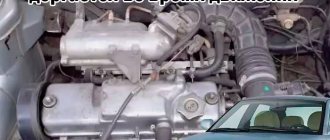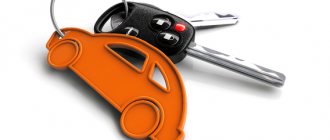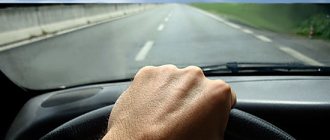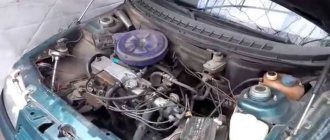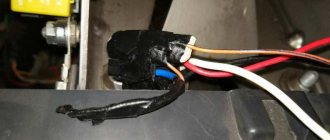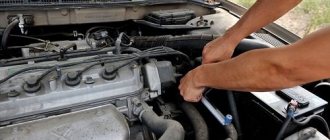Malfunctions and disturbances in engine operation can manifest themselves in different ways, starting with suspicious sounds coming from under the hood, leaks that remain on the asphalt after a long stay, ending with jerks while driving.
Jerking while the car is moving can occur no matter how much you press the gas pedal; this occurs as a result of a short-term change in the speed of rotation of the crankshaft. Dips can occur not only during acceleration, but also when releasing the gas, as well as with constant movement and the same position of the gas pedal. In order to understand why the car jerks when driving, it is best and easiest to contact specialists at a service station, because, most likely, you will have to carry out a complete diagnosis of the fuel system and injection system, and for this, as you understand, you need to have special equipment . In most cases, jerking while driving occurs due to a lack of pressure in the fuel rail, or as a result of a malfunction of the throttle position sensor (TPS).
Failures in the engine power system
The main fault causing the jerk is the wrong fuel mixture. Because of this, the car behaves non-standardly:
- twitches when you press the gas pedal and does not gain speed or does so very reluctantly;
- suddenly and spontaneously changes speed.
A lack of gasoline or diesel fuel in the fuel mixture does not allow the engine to develop standard power. Why does the power system fail? There are several reasons: filter, throttle assembly, fuel rail, air ducts. These units become clogged or worn out, lose their tightness or pressure. In all cases, proper diagnostics are required to find and fix the problem.
Electric gas pedal
A common reason when the car jerks is the failure of the electronic gas pedal. Modern cars have an electronic gas pedal. It works on the principle of a potentiometer and has a structure similar to it. Like any potentiometer, it has tracks along which the sensor runs. This sensor is mechanically connected to the pedal.
Although the gas pedal housing is hermetically sealed, it sometimes happens that moisture gets into it, and as you know, electronics do not like moisture. Since the tracks are made of metal, they begin to corrode. This reduces contact with the sensor. The pedal starts to work incorrectly and the car jerks when you press it. Dips are felt both at idle and while driving.
Incorrect operation of the ignition system
The ignition system also causes unstable engine behavior due to:
- spark plugs - the fault is easily determined by the color of the deposit and the size of the contact gap;
- high-voltage wires - it is recommended to check with a megger;
- coils - visually inspected for cracks and current leakage.
It is advisable to check spark plugs with a special spark plug. It will allow you to correctly determine the gap between the electrodes, which is normally 1-1.3 mm (on carburetor cars - 0.7-0.8 mm). Increasing this value leads to damage to various ignition system devices. Any known-good spark plugs are also used as a tester.
The coil is also checked for spark. Diagnostics will require a spark plug wrench and pliers. During the test, the ignition must be turned off. Then any armored wire is removed and connected to a known working free spark plug. Next, the engine is started and the spark that appears between the electrodes of the spark plug is examined. Its color should be bright purple.
Poor engine performance is often caused by a short circuit or open circuit in the low voltage circuit. Incorrect connection of the wires to the spark plugs also significantly reduces the performance of the internal combustion engine, causing interruptions.
Jerks are caused by crankshaft and air position sensors
Incorrect data on the amount of air flow entering the engine causes the injector to open incorrectly. As a result, the preparation of the fuel mixture will deviate from the norm. The engine operates with dips during acceleration - this is also the “work” of the crankshaft position sensor. It provokes incorrect formation of an ignition spark when the injectors open. The malfunction of these two sensors can be identified after diagnostics.
Experts recommend cleaning the throttle valve regularly. In addition, on many cars it is necessary to carry out manipulations to adapt the throttle valve after cleaning it. You can prevent problems if you get into the habit of cleaning the element at least a couple of times a year.
Transmission breakdowns
Engine malfunction may be caused by damage to the transmission. Most often, the clutch wears out or the grenades break. Less often, the gearbox and its mounting components, including the supports and brackets of the power unit, fail.
The most difficult thing to determine is the failure of the gearbox and clutch - they have to be dismantled and disassembled. It is much easier to diagnose the condition of the airbags and CV joints by using a lift or inspection hole. To check their mobility, the hinges are pumped in different directions. Breaks in motor supports are detected as follows: take a long crowbar and lift the motor (box) near the attachment points. Damage is immediately noticeable.
The calibration of the motor control unit is broken
In a modern car with electronics, a faulty sensor or module is indicated by the “Check Engine” lamp. There are cases when there are no problems with the engine or sensors, but interruptions during acceleration are still present, the engine trembles, jerks and does not want to accelerate. The reason for this behavior is poor calibration of the control unit. Symptoms with twitching during acceleration may not always occur, but only until the engine warms up.
The engine twitches when accelerating in the notorious Lada Vesta Cross, equipped with a 1.8-liter engine. Until the engine is fully warmed up, it begins to jerk when accelerating. The reason is insufficient supply of fuel to the combustion chambers during acceleration. Here you need a flashing, and if it hasn’t been released, you just have to suffer and wait for updates.
If the unit is faulty and the firmware does not solve the situation, then only replacing the control unit will get rid of the twitching. It is important not to delay repairs, because unstable operation increases the wear of car engine parts and brings expensive major repairs closer by leaps and bounds.
Bad fuel
Today, fuel is spoiled not only by water, but also by various unknown additives. This fuel contains a lot of sulfur, benzene, aromatic hydrocarbons and ethers. Therefore, all vehicle systems are subject to increased loads. First of all, the injector, ignition, and exhaust suffer. Then, due to increased detonation, the engine overheats - the pistons, rings, and cylinder walls are damaged.
If you have already poured a low-quality composition, get rid of it immediately! Empty the tank, flush the fuel system, clean the injectors and replace the spark plugs. Only after these steps, refuel with good fuel.
Diagnostics
The diagnostic procedure for different engine designs is performed according to a different algorithm.
However, there are general faults. During the process, it is necessary to check the fuel system, air supply lines, and ignition apparatus. In this case, troubleshooting is performed one by one for all units. If the sequence gives a result, the damaged node is replaced with a known good one (new).
Clogged air and fuel filters
On cars of recent years of production, several fuel filters are used. Their main task is to capture large and small deposits and impurities - the power system and internal combustion engine do not tolerate dirty fuel well. There are fine and coarse cleaning elements - the latter are a mesh and are located inside the fuel pump. The filter life is limited - they last 15–30 thousand kilometers. The mesh can last up to 100 thousand km. The main sign of blockage is jerking and jerking of the vehicle. At the same time, other disadvantages arise:
- fuel consumption increases;
- The power of the power unit decreases - acceleration deteriorates;
- The motor stops spontaneously at idle or while moving.
A dirty fuel filter is replaced, or less often cleaned.
Almost the same thing happens with a dirty air filter. The car jerks even more intensely, and engine detonation increases. Then the spark plugs fail, and all the electrics begin to “go crazy”, showing various warnings such as Check Engine on the display. A new filter costs about 200–300 rubles, so it is advisable to replace it frequently - every 10 thousand kilometers.
What to do
If you lack knowledge or lack confidence in your own abilities, you can seek help from a service station, where specialists will conduct a diagnostic examination and repair the car.
If the user decides to figure it out on his own, he must do the following.
When I press on the gas, the car jerks and does not move.
In the case when the car behaves predictably at idle, and when the trigger is pressed, jerks are felt, and the car slowly picks up speed. The problem lies in the lean or over-enriched mixture entering the cylinders. It doesn’t matter whether it’s an old VAZ or a new modification like the Hyundai Accent. The original source is located here.
The secondary question is how this happens, because in 50% of cases the carburetor or injector is configured correctly.
The car jerks when accelerating and pressing the gas sharply
Similar symptoms occur on fuel-injected foreign cars - when the trigger is pressed firmly, the car jerks. In this case, acceleration occurs in normal mode. For cars such as Ford Focus, Opel Astra J, Chevrolet Cruze, the problem may be a breakdown of the ECU, mass air flow sensor, or TPS. The problem also does not avoid modifications of the VAZ 2114 and Audi A6 C5. The easiest way to diagnose is to replace parts with obviously new ones. Thus, the throttle position sensor may become “stupid”, incorrectly indicating to the ECU the location of this unit, which causes variable throttle opening with all the ensuing consequences. Also, the mass air flow sensor may incorrectly interpret the indicators, which will cause the mixture to become leaner.
When you press the gas pedal, the car stalls, then jerks sharply
When a vehicle stalls during acceleration, followed by a sharp jerk, and then the dynamics stabilize. The following items need to be checked:
- air line;
- accelerator pump;
- fuel quality;
- checkpoint;
- main fuel pump;
- ignition settings;
- MRV sensor.
Owners of the Lada Priora periodically face the problem of fuel pump failure. Here it will be enough to replace the element with a new one, to be on the safe side, clean the lines (low-quality fuel could get in).
Also, in some cases, the engine begins to stall and then accelerate. Here, the mass air flow sensor is checked, the spark plugs are diagnosed, the ignition angle is checked, and the injectors are clogged.
Additionally, if you have an automatic transmission, you need to check this mechanism. About 20% of visits to a car service center with similar faults end in “treating a surprise” inside the torque converter.
The car jerks while driving when the gas pedal is pressed lightly
A more exotic malfunction is when, when you smoothly press the trigger, the car begins to twitch until the power plant reaches a certain speed. There is a lack of combustible mixture in the float chamber of the internal combustion engine - gasoline burns faster than it can flow. This is a side effect of a faulty fuel pump; the unit does not have time to pump a new portion of the mixture, which provokes engine jolts.
Note! On independent designs like the carburetor Oka or the injection Lanos, the breakdown in 90% of cases manifests itself in the same way, which narrows the search area.
The car jerks when you press and release the gas
If, when the speed is reduced, the car begins to nod, and during acceleration it jerks again, there may be two sources of the problem.
- Sensor failure. Faulty sensors send incorrect data to the ECU, causing a disruption in the uninterrupted fuel supply.
- Clogged dosing elements (nozzles, jets). Owners of classic models such as the VAZ 2107 often encounter a similar problem. A clogged injector, after releasing the gas, “spits out” part of the fuel, which causes an increase in speed. During sudden acceleration, the element does not have time to supply the required amount of mixture to the cylinder.
Carburetor car jerks when you press the gas
If a problem is detected on carburetor vehicles such as VAZ 2109/2106. First of all, you need to pay attention to the fuel supply system . The design of standard Solex carburetors has outlet tubes designed to supply gasoline to the mixture formation chamber. By pouring low-grade fuel, thin channels can become clogged, which prevents its free passage. Usually the channel of the first chamber is clogged. If the engine jerks while gaining speed, and after reaching 2500-3000 rpm the acceleration proceeds smoothly - this is where the trouble lies.
The defect is eliminated by purging the unit with compressed air and preliminary cleaning the jets (just in case).
It is also necessary to check the main pump (a problem with all classics), and the ignition timing.
When you press the gas, a car with an injection engine jerks
If the injection VAZ 2110 twitches, the search for the problem should start from the MVR, PDZ, and ECU sensors.
In this case, faulty sensors can send a false signal to the control unit, which is the primary source of the trouble. The next reason is clogged injectors. Symptoms usually appear 15-20 km after filling low-quality fuel into an empty tank.
The last point is failure, ignition interruptions. Spark plugs and armored wires are diagnosed.
Diesel car jerks when pressing gas
Regarding diesel engines, the solution to the problem is extremely simple - jamming of the moving blades of the main pump. The reason for this phenomenon is considered to be long-term downtime of transport in a damp place. It is moisture that oxidizes metal surfaces, which leads to jamming of the structure.
Failure repair is carried out by replacing the damaged part.
Clogged or faulty injectors
During prolonged operation of an injection engine, varnish and resin deposits from fine particles and heavy fractions of sulfur, hydrocarbons, and ethylene accumulate on the injectors. They greatly slow down the operation of the injection system, change the direction and shape of the spray, and in some cases completely shut off the fuel supply. Obviously, in such a situation, the formation of fuel worsens, the tightness of the regulators is broken, and the overall performance of the internal combustion engine decreases. Therefore, the car moves jerkily and twitches.
Replacing injectors according to manufacturers' recommendations should be done every 120–150 thousand kilometers. But it’s much more important and important to clean them. This must be done at least every 30 thousand mileage, especially in Russian road conditions.
Popular brands:
Kia Sportage
Simple DIY repair
If it is difficult to find the reason why the car moves jerkily when driving, you should contact a car service center and carry out diagnostics, but before sending the car in for repair, the driver can carry out basic maintenance himself. What you can do with your own hands:
- replace the air and fuel filters;
- clean the engine and attachments from dirt;
- check the condition of high-voltage wires and the ignition module;
- conduct a visual inspection of the engine compartment - there should be no oil leaks, traces of brake fluid or antifreeze;
- Replace the air filter pipe if it is torn.
A dirty engine often causes high-voltage wires to break through to ground. It is convenient to check whether the ignition coil or I/O wires are breaking through in the dark and silence; any sparking becomes clearly visible visually, and you can also hear clicks when a breakdown occurs.
Other reasons
Engine malfunctions are also caused by other factors:
- problem of the idle speed sensor - contamination, damage or combustion of the winding;
- dysfunction of the fuel tank - often in summer a vacuum forms inside the tank due to a tightly fitting filler cap, the pump is not able to pump out fuel normally;
- damage to the fuel pump - you can check the operation of the unit without removing it, just evaluate how the mechanism pumps manually;
- wear of the distributor - it should be dry under its cover, be sure to also check the operation of the vacuum and centrifugal regulator;
- incorrect setting of ignition timing;
- incorrect operation of the processor - electronic control.
Remember that failures are also caused by the engine itself - breakage of oil scraper rings, burnout of pistons, scuffing of cylinders. It is possible to accurately determine the “culprit” only after a detailed inspection of the machine components.
It is better to entrust diagnostics to specialized car services, as they do in Moscow, St. Petersburg, Novosibirsk and other cities. For example, on BMW models, a drop in engine power is possible due to the VANOS sensor, and on Mercedes-Benz and some other foreign cars - due to a “glitch” in the program responsible for integrating the engine with the gearbox. This can be checked correctly only with professional instruments.
The car jerks when driving when changing gears - check the gearbox
If you have a car equipped with an automatic transmission (whether it is a standard automatic transmission, a CVT or a robot), most likely, this module is the reason why the car jerks while driving. Any problems that arise when shifting gears are related to the operation of the box, but this cannot always be determined. Especially great difficulties arise when using a CVT variator - a continuously variable transmission.
The most common problems with car jerking when switching occurred with German tiptronics installed on many models in 2002-2007. If you find problems with the car jerking when automatically shifting on a standard automatic, robot or tiptronic, perform the following test procedures:
- increase the acceleration dynamics and try to notice whether the car jerks when switching to the last gear;
- switch the transmission control mode to manual mode and check if the twitching disappears;
- check whether the symptom continues when shifting to lower gears;
- Drive for a few minutes in one gear (not the last one) and note the symptoms.
If the car twitches during any switching options, it means that the gearbox is definitely involved in this problem. In some cars, repairing a high-tech automatic transmission turns out to be too expensive, sometimes an aggregate replacement can be cheaper.
If you have a CVT installed on your car, it is impossible to determine its involvement in unpleasant manifestations. You will have to go for diagnostics and clarify the reasons for this behavior of the car. In this case, it is better to choose an official service station with branded equipment. Otherwise, the diagnostics may not be of sufficient quality, you will be told to replace the working units, and you will have to spend a lot of money on unnecessary repairs.
Candles
When the car jerks and does not gain high speed, you should immediately check the condition of the spark plugs. The appearance of carbon deposits, burnout of electrodes, and damage to the integrity of the ceramic insulator cause a weakening of the spark and misfires. The car starts to jerk when accelerating, the speed drops. It is also worth checking the gaps between the electrodes; perhaps they are too large or too small.
There are often cases when a problem occurs after replacing spark plugs, there are two reasons for this:
- Not all spark plugs are the same - you bought and installed parameters that are unsuitable for your engine - either the heat rating or the gap does not match;
- Only 1-2 non-working spark plugs were replaced, the rest were left the same. This is the most common mistake; new spark plugs may not match the parameters of the old ones and may fail. Old spark plugs may fail one at a time, you have replaced those that are clearly not working, and the life of the others is already coming to an end;

